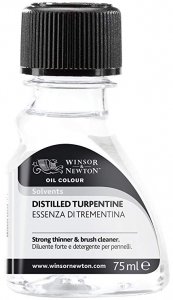Description
Cremnitz White No. 2 (Walnut Oil)

??Inorganic
| Colour Index | PW 1 |
| Drying Speed | Average |
| Lightfastness | Excellent |
| Tint Power | Slightly Transparent, Average Covering Power |
| Oil Content | Walnut Oil, Very Low |
| Toxic | Yes |
| Conforms To | ASTM D-4236 |
??The combination of pigment and walnut oil produces some wonderful qualities, possibly due to its lesser ability as a wetting agent, which results in less pigment within the actual mixed paint and therefore increases transparency and subtler intermixes with colours. There is inaccurate material publicized by some colourmen that walnut oil goes rancid and therefore is not to be relied upon as a drying oil which is completely untrue! It was used along side linseed oil for centuries and found favor with just about all artists who worked with it. Most artist, dare I say, who try it love it!
The use of walnut oil in paint can be traced back even further than that of linseed. When 15th century artists began to add oil to their tempera colours it was walnut oil that seemed the obvious choice. Jan van Eyck in Flanders and Antonello da Messina in Italy both knew of its handling properties; from that time on it was widely used by just about all the great artists, being more a question of who did not use it rather than who did.
I thought it would be interesting to bring back this oil as a binder for lead white. It survived as the binder for the white made by French colourmen selling to the Impressionists, but it seems to have fallen out of use by the end of the 19th century. I believe the reason for this was its expense. Even today it costs about 3 times the price of linseed oil. But since lead paint needs little oil, the increased cost is less evident. Some accounts I have read speak of its tendency to go rancid, but I suspect this is less of a reason for its demise and more an offered excuse to drop it in favour of other, cheaper oils. Upon researching this matter I can find no evidence of the oil spoiling in any way, particularly while incorporated into the form of an oil paint.
There was in fact good reason why walnut oil was preferred as a binder for whites: it has the reputation for yellowing slightly less than linseed, and so paler and cooler colours bound with it underwent less change in drying. The film of dry walnut-bound paint is not quite as strong as that bound with linseed, but it is stronger than that of poppyseed oil, and this permits walnut-bound paint to be overpainted in a way which would risk later cracking if poppyseed oil had been used. Walnut oil dries at a rate comparable to linseed. I have read accounts of how it was particularly useful for the very detailed work demanded by work such as portraiture. I suppose the works of the 15th century masters cited above demonstrate just how refined its handling could be.
It is the feel of this paint under the brush, I think, which constitutes the most compelling argument for its revival. My artist friends have characterized its texture with words like “voluptuous” and “silken”. There is certainly a flow to i








